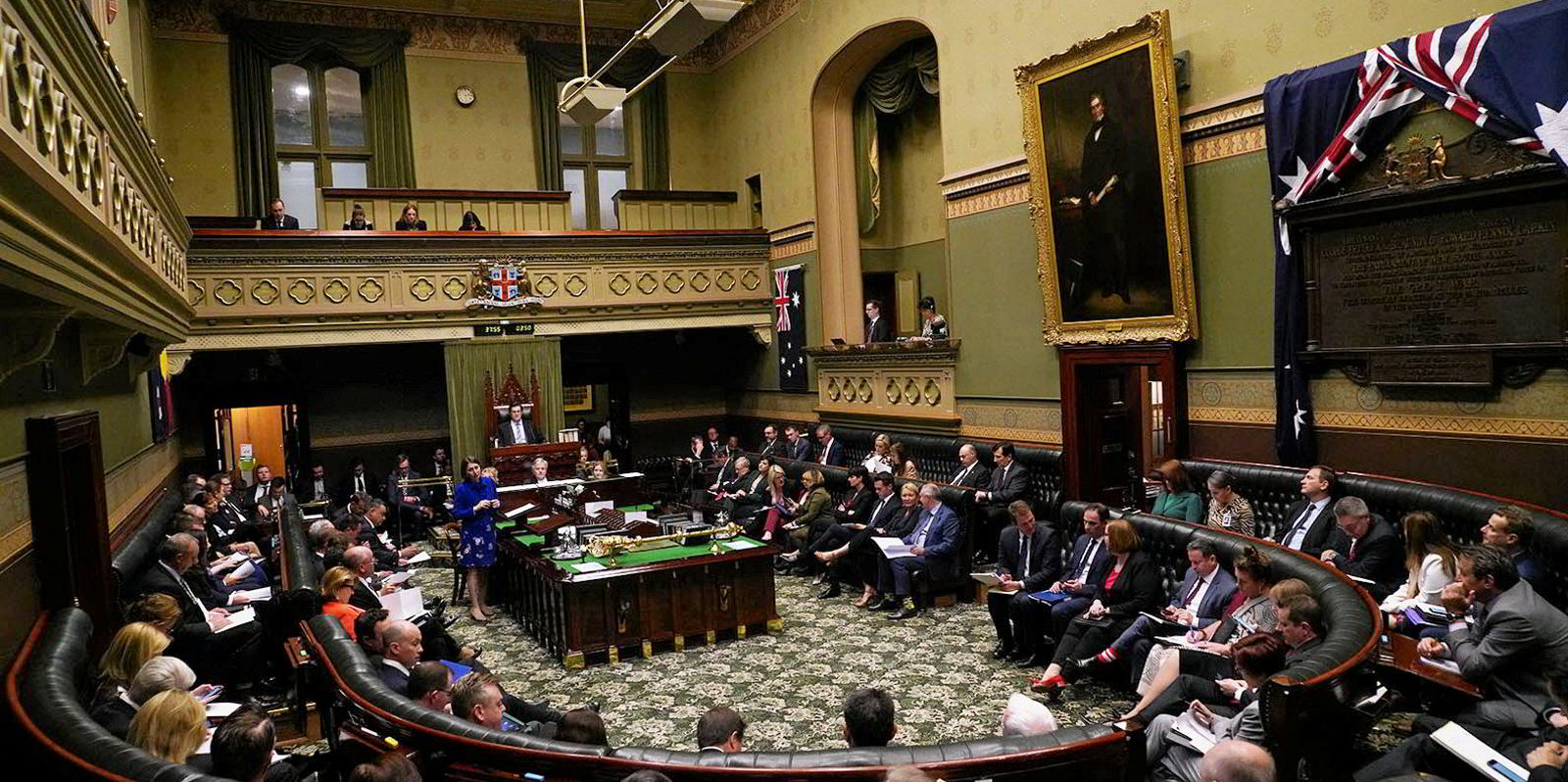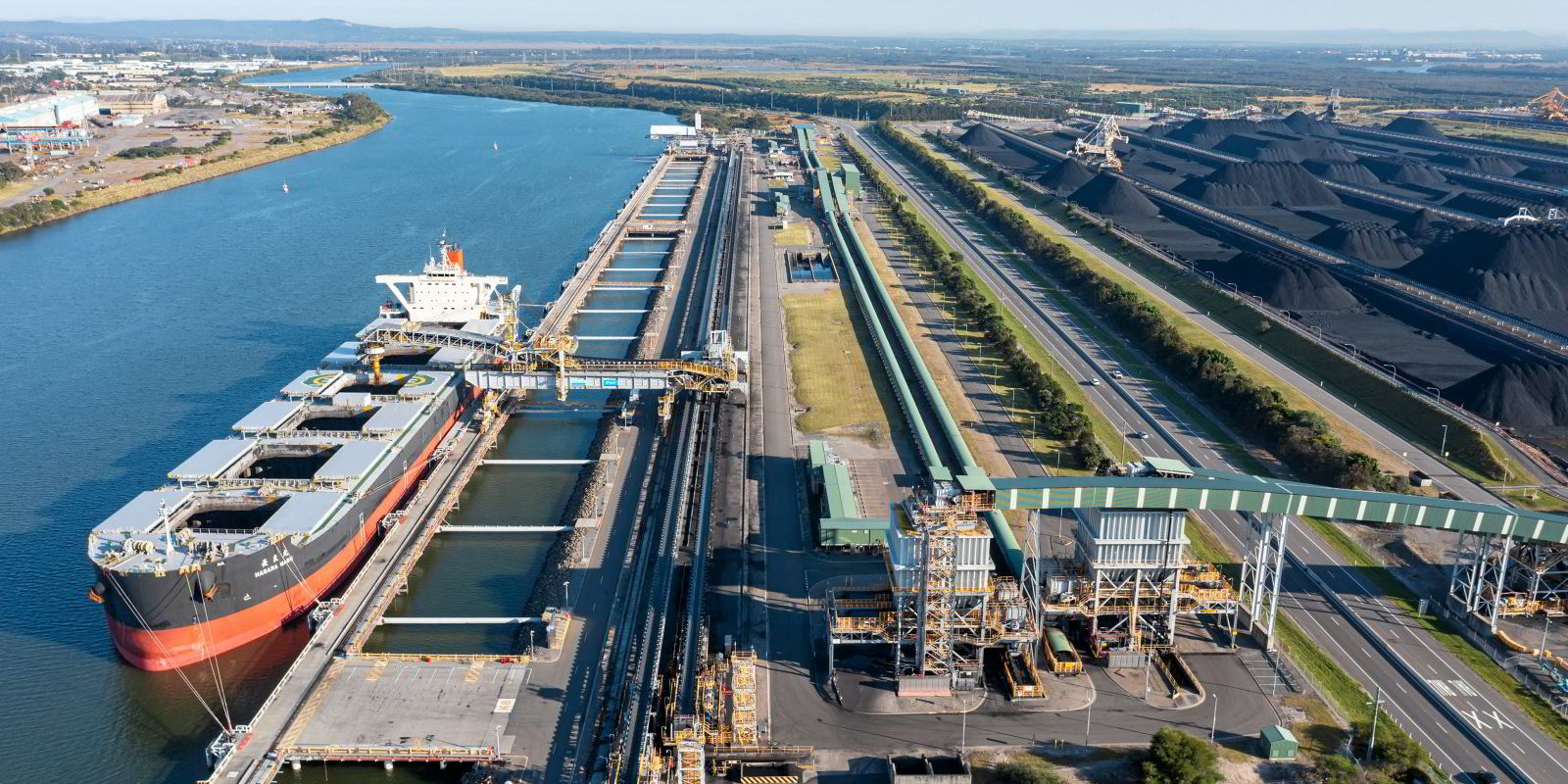
Page added on November 25, 2021
Next door, 3kg of gunpowder has compressed 1,500 litres of hydrogen to 10,000 times atmospheric pressure, launching a projectile down the 9-metre barrel of a two-stage light gas gun at a speed of 6.5km per second, about 10 times faster than a bullet from a rifle.
On the monitors the scientists are checking the next stage, when the projectile slams into the target — a small transparent block carefully designed to amplify the force of the collision. The projectile needs to hit its mark perfectly flush. The slightest rotation risks derailing the carefully calibrated physics.
“Thank God,” exclaims one of the technicians, after reviewing a video playback of the impact of the scientific artillery. It was the perfect shot.
Those in the room at First Light Fusion, in a business park outside the English city of Oxford, had just witnessed another hopeful step in a 60-year mission to answer one of science’s most complex problems: how to harness the fusion reaction that powers the sun to generate clean, limitless electricity on Earth.
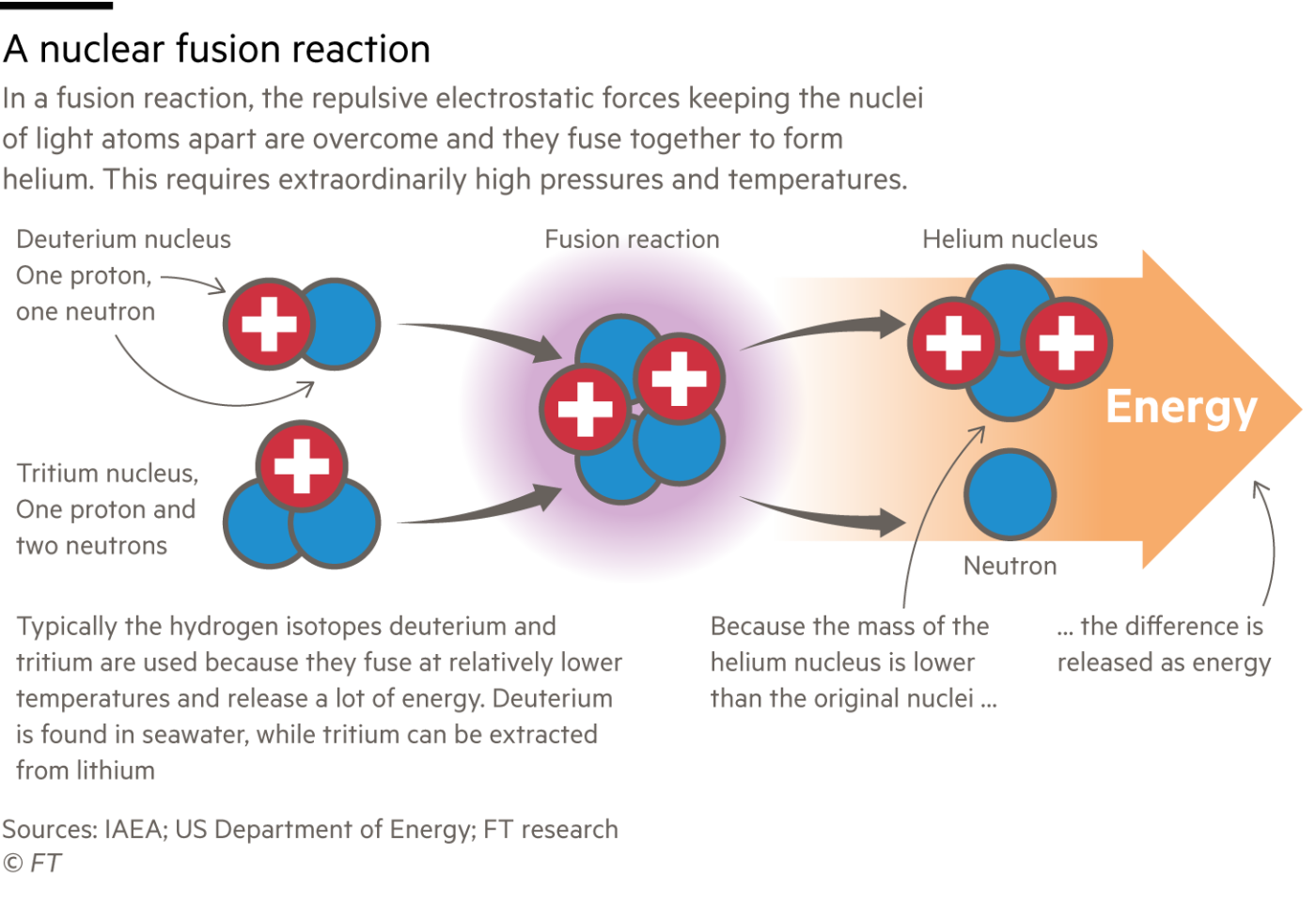
The potential of fusion energy, first pioneered by the Soviet Union, has tantalised scientists for decades but has always seemed just out of reach.
“Fusion is probably the greatest technical challenge humanity has ever taken on,” says Arthur Turrell, whose book The Star Builders charts the decades-long effort by engineers, physicists and mathematicians to achieve what some still believe is impossible. “How close it is depends not on time, but on the will, the investment and the commitment of resources to actually get there.”
A growing number of private companies, including First Light, are now hoping to commercialise those years of public research by proving fusion power can work and connecting it to the grid as soon as the 2030s.
Unlike nuclear fission when atoms are split, fusion does not produce significant radioactive waste and could never result in a nuclear accident, such as Chernobyl. The most efficient chemical inputs for fusion — deuterium and tritium — are also widely available.
Just one glass of the fuel created by the process has the energy potential of 1m gallons of oil and could generate, depending on the fusion approach, as much as 9m kilowatt hours of electricity, enough to power a home for more than 800 years, scientists estimate.
Those characteristics, its proponents say, mean fusion, by providing cheap, unlimited zero emissions electricity, could genuinely save the world.
“I couldn’t be more optimistic,” says Silicon Valley venture capitalist Sam Altman, who recently invested $375m in the US fusion start-up Helion. “In addition to being our best path out of the climate crisis, less expensive energy is transformational for society.”

A Soviet-era idea, taken private
Soviet physicists developed the first fusion machine in the 1950s using an approach known as magnetic confinement fusion. The tokamak — short in Russian for toroidal chamber with magnetic coils — enabled a plasma of deuterium and tritium, both hydrogen isotopes, to be held in place by powerful magnets and heated to temperatures hotter than the sun so that the atomic nuclei fuse, creating helium and releasing energy in the process.
The problem is that while scientists have become adept at fusing the two isotopes, the Soviet tokamak, and all other fusion systems developed since, require a vast amount of power. And in more than half a century of trying, no group has been able to generate more energy from a fusion reaction than the system consumes.
“When will we get electricity from fusion? Who the hell knows?” says Steven Krivit, a science writer who for 20 years has been a critical observer of fusion energy’s false starts. “Until we see somebody delivering electricity cost effectively we’re still doing science, we’re not doing technology.”
But after a series of public and private sector breakthroughs in the past six months, some industry participants are far more hopeful. In China in May a machine known as East — the Experimental Advanced Superconducting Tokamak — managed to sustain a fusion reaction at 120m degrees Celsius for a record 101 seconds. Temperatures over 100m C generally required for magnetic confinement fusion had been attained before but never sustained for such a long time.
Then in September a Boston-based start-up demonstrated the use of a high-temperature superconductor to generate a much stronger magnetic field than a traditional tokamak. The group, Commonwealth Fusion Systems, which grew out of the Massachusetts Institute of Technology, believes the discovery will enable it to make a more efficient fusion machine that will be smaller, cheaper and more viable as a commercial source of power.

Bob Mumgaard, CFS chief executive, compares the breakthrough with the evolution of computing. “Computers, back when they had vacuum tubes, took up whole rooms. Then when they had transistors you could make the computers smaller and, all of a sudden, people that weren’t doing computers could do computers,” he says.
“Fusion has so many really desirable attributes, if you think about what is required for the entire world to live in the way people deserve to live and to also have a liveable planet,” he says. The next step towards power production is the construction of a demonstration plant called Sparc, about half the size of a tennis court, which CFS hopes will achieve net energy by 2025 and then a commercial power station in the 2030s.
“We’re using known science, with new engineering and new materials,” says Francesca Ferrazza, a physicist at the Italian oil major Eni, which has collaborated with MIT since 2008 and is the largest outside investor in CFS. “The ambition would be to be a player in the [fusion energy] field with a substantial presence in various parts of the value chain,” she says.
“Fusion is coming, faster than you expect,” says Andrew Holland, chief executive of the newly formed Fusion Industry Association, which counts the number of private businesses in the sector worldwide at 35 and growing.
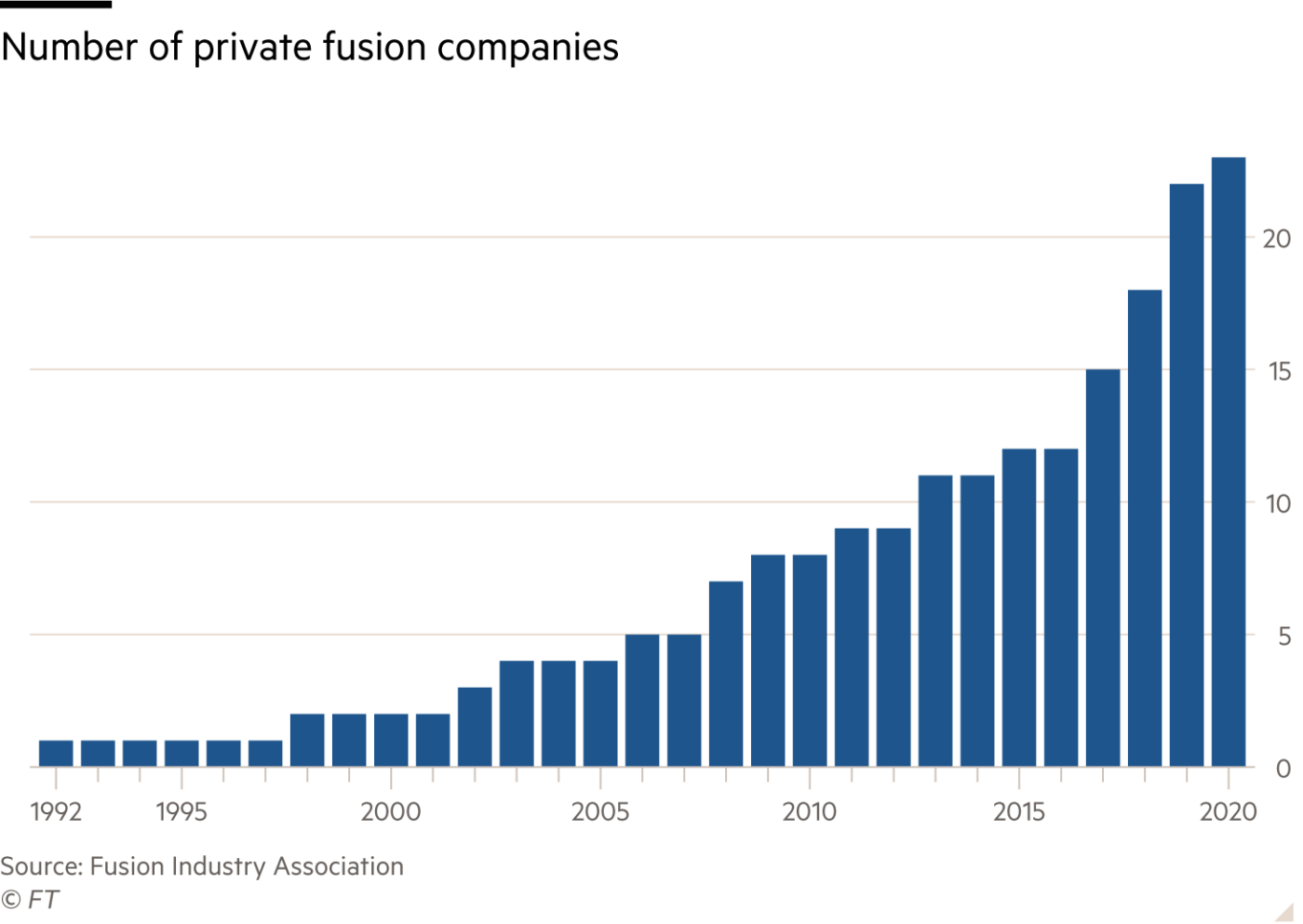
A patient wait
Private participation in the sector is relatively new. In the second half of the 20th century fusion research was advanced by international public consortiums and the biggest projects in the world remain government-funded.
The US Department of Energy helped establish MIT’s Plasma Fusion Center — now the Plasma Science and Fusion Center — in 1976 in response to the oil crisis and rising prices. The Joint European Torus, which remains the world’s most advanced tokamak, was opened in Culham, a village south of Oxford, in 1984. Then in 1985 US president Ronald Reagan and Mikhail Gorbachev, his Soviet counterpart, agreed to co-operate on ITER — the International Thermonuclear Experimental Reactor — the world’s largest nuclear fusion project, to ease cold war tensions.
Some experts believe ITER is still most likely to produce net energy first, but the project, a collaboration between 35 countries that remains under construction in France almost 40 years later at an estimated cost of more than $20bn, has become a byword for glacial progress.
“None of the private fusion companies would be here today without the science that was developed in the ITER programme,” says Christofer Mowry, chief executive of Canada’s General Fusion. “But the cost and timeline for ITER should not be used as a point of reference for what it takes to develop and commercialise fusion energy.”
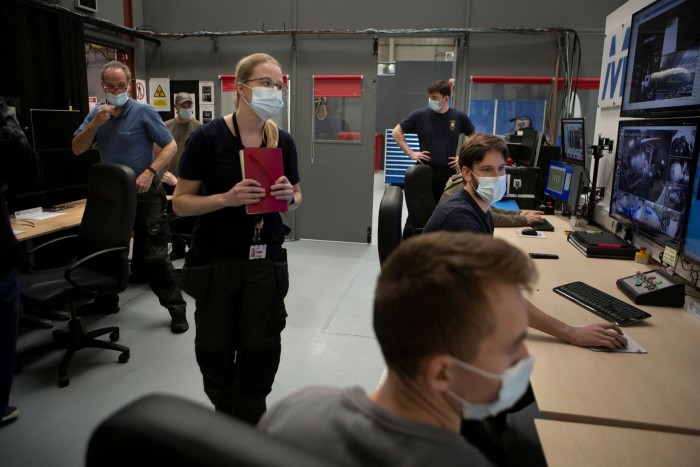
Mowry, who joined the Jeff Bezos-backed company in 2017, is certain it will be the private sector that makes fusion power a reality. He compares it to the role Elon Musk’s SpaceX has played in advancing the prospects of commercial access to space.
“SpaceX did not invent the science of rocketry. It took 50 years of research, sprinkled a little bit of these modern technologies and made a better, faster, cheaper Apollo,” he says, referring to the US space agency programme.
General Fusion’s approach, which it calls magnetised target fusion, is unusual in that it has been designed with a commercially viable power plant in mind, Mowry says. It uses an array of steam-powered pistons to rapidly compress the plasma to fusion conditions and a wall of liquid metal to absorb the heat from the reaction, which is then used to produce steam to drive a turbine generator. Construction on its first demonstration plant is scheduled to start next year, also at Culham, and be completed in 2025.

In total, private fusion companies have raised $2.3bn in investment, according to the industry association. More than a fifth of that funding was raised just this month by Altman’s Helion, which uses yet another approach that it calls pulsed non-ignition fusion. It involves raising the temperature of the fuel to 100m C in a 40-foot-wide, six-foot-high dumbbell-shaped “plasma accelerator” to capture the energy as the reaction expands and pushes back on the system’s magnetic field. Mowry argues that the variety of approaches is one of the emerging sector’s strengths. “Private industry accepts more risk to go faster and cheaper,” he says. “That means that not all shots will go in but the world doesn’t need them all to go in.”
A tainted sector
At First Light in Oxford, the scientists’ hopes are pinned not on the gas gun — which is used to test the science but will not be part of the future power system — but on the target used to house the deuterium-tritium fuel and amplify the impact of the projectile.
First Light’s hypothesis, based on the theory of inertial confinement fusion, is that by firing a projectile at the target at speeds in excess of 20km a second — enough to travel from London to New York in 4 minutes — they can create enough energy to force the deuterium and tritium to fuse, vaporising the target, while generating the energy equivalent of burning 10 barrels of oil.
Founded by 36-year-old chief executive Nicholas Hawker and his former physics professor Yiannis Ventikos, First Light is cagey about the target’s composition and design, which the company keeps closely guarded. The replica at their headquarters — a clear cube, a little over a centimetre wide, enclosing two spherical capsules — looks like a prop from a superhero movie.
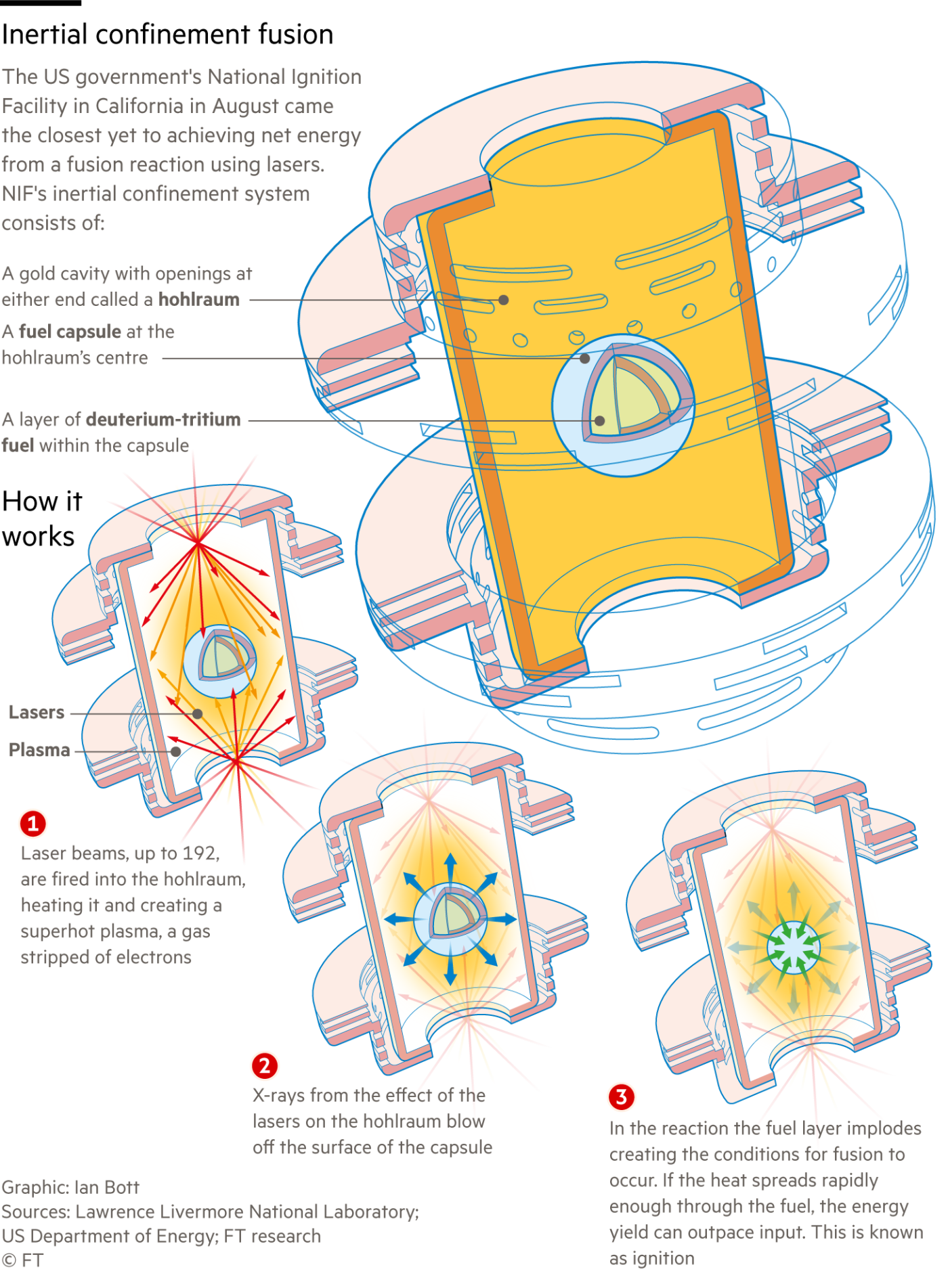
“It is the ultimate espresso capsule,” says Hawker, explaining that First Light hopes to manufacture and sell the targets to future power plants — built to its design — which would need to vaporise one every 30 seconds to generate continual power. He was drawn, he says, to “working beyond the edge of human knowledge”.
It is exactly this complexity, however, that makes claims difficult to verify and has tainted the sector.
In 1951, at the height of the cold war, Juan Perón, Argentina’s president, convinced the world his scientists had harnessed fusion power, generating global newspaper headlines. Fusion fuel would soon be available, like milk, he said, in half-litre bottles. Almost four decades later in 1989, two chemists at the University of Utah said they had been able to fuse nuclei at room temperature in a simple electrochemical cell on a lab bench, a claim that unravelled in weeks.
Such incidents continue to weigh on the industry. Krivit, the science writer, argues that until a group shows it can generate electricity from a fusion reaction, prospective investors should treat private companies’ claims with scepticism.

A First Light engineer works on an electro magnetic launcher near Oxford. One glass of the fuel created by the fusion process has the energy potential of 1m gallons of oil
A First Light engineer works on an electro magnetic launcher near Oxford © Tom Pilston/FT
Yet progress is undoubtedly being made, including at the US government’s National Ignition Facility, where in August scientists used 192 lasers to generate a fusion reaction that appears to have come the closest yet to achieving net energy.
“It was the biggest breakthrough in fusion for literally decades,” says Turrell, adding that getting fusion energy on to the grid in 2030 is a “great ambition”.
“But if they get there in 2040 instead that is still going to be a huge win for the world,” he adds. “And even if they get there after 2050 and the world has [already] reached net zero that will still be a massive win for humanity because we need a portfolio of energy sources.”
At that stage, Turrell says, fusion could be used to power energy-intensive carbon capture systems enabling the world to begin to reverse, rather than slow, some of the environmental damage brought by climate change.
Hawker echoes that view. Existing renewable energy sources, particularly wind and solar power, can be scaled up to replace fossil fuels but will struggle to also meet forecast increases in power demand owing to the electrification of the global energy system and rising energy consumption in developing countries, he says.
In 2050, the world will need 12 times more clean electricity than is produced today, he says, citing the work of climate author Solomon Goldstein-Rose. “Anything at all that we have which adds on top of the existing picture is a great thing,” Hawker says, “and we should be doing it at maximum speed.”
FT


:quality(70):focal(-5x-5:5x5)/cloudfront-eu-central-1.images.arcpublishing.com/thenational/GOSNIKBDWJBOJGGI5C4VV4WYHY.jpg)
:quality(70)/cloudfront-eu-central-1.images.arcpublishing.com/thenational/U3O3K6FUDKK6DTGAMNJNEBDBNQ.jpg)
:quality(70)/cloudfront-eu-central-1.images.arcpublishing.com/thenational/7Z5UVOJD6JBHPIFXD7HWWPJAXI.jpg)
:quality(70)/cloudfront-eu-central-1.images.arcpublishing.com/thenational/QXXKIVN6ONBMTG5VJWCSD5PWOU.jpg)
:quality(70)/cloudfront-eu-central-1.images.arcpublishing.com/thenational/6ARY2MZGVBHC5DRBWC2KY722FA.png)
:quality(70)/cloudfront-eu-central-1.images.arcpublishing.com/thenational/2DTXIULUFNEDNIUA2CSQ5P3RDQ.jpg)
:quality(70)/cloudfront-eu-central-1.images.arcpublishing.com/thenational/YMT544WW4FHFBPDLGRHXK3ULOY.jpg)
:quality(70)/cloudfront-eu-central-1.images.arcpublishing.com/thenational/QOMMIBORNJFCVBBVVE644ZHUYA.png)
:quality(70)/cloudfront-eu-central-1.images.arcpublishing.com/thenational/UDQDRNODJNNNKUGV2T3DNQI5O4.jpg)





